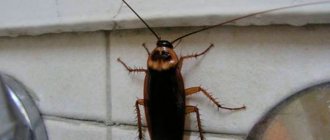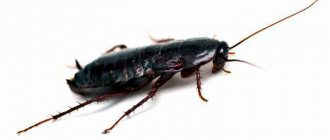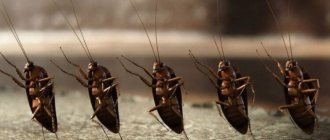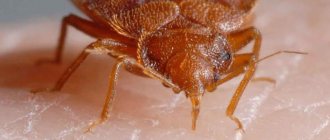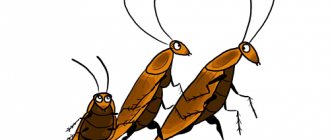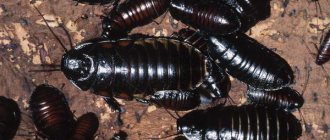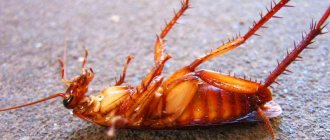General information
Cockroaches (or cockroaches) are a detachment of insects from the superorder Cockroaches. According to archaeologists, representatives of the cockroach order lived on Earth more than 300 million years ago.
Today, more than 4,600 species of cockroaches are known. Despite the fact that cockroaches are moisture- and heat-loving insects, their habitat is almost the entire planet. The exception is Antarctica, where the mustachioed pests have not yet reached. Most cockroaches live in the wild, living in meadows, swamps, forests and even underground. But some of the representatives of the cockroach order are synanthropes, that is, their way of life is directly related to humans, and they most often live in human housing.
Spread diseases
Cockroaches can be dangerous to people, as they are carriers of dysentery and worms.
Remedies for cockroaches
Insects of absolutely any type and color of shell are equally unpleasant to people. Therefore, seeing at least one individual in their apartment, people immediately make attempts to get rid of them. There are many methods and means that are effective in the fight against Prussians. For more information about this, read the article “How to get rid of cockroaches quickly and effectively?”
Tarax
A very effective remedy for all types of cockroaches. The release form is a powder that must be dissolved in a glass of water. Then the resulting solution should be used to treat places where insects accumulate and their possible paths. The drug creates a microfilm of insecticides, upon interaction with which the insect dies. The cockroach repellent Tarax is not sold in retail stores; it must be ordered online.
Fas
This insecticide is a white powder and is sold in 10 gram bags. It is dangerous not only for insects, but also for humans, so you should work with it carefully. The prepared solution should be sprayed in hard-to-reach places and crevices. After the procedure is completed, it is necessary to ventilate the apartment. The drug Fas for cockroaches has good reviews from exterminators and has been used by them for a long time when treating premises.
Raptor
In addition to the high content of insecticides in the Raptor aerosol, this product also has a pleasant smell. It can cause harm to a person only if it gets on the mucous membrane. To completely eliminate a colony of cockroaches, just one treatment is enough, since the validity period of such a spray is quite long. This product can rightfully be called the most effective in pest control, since Raptor aerosol for cockroaches has the best consumer reviews.
Baron
The manufacturers of this product have studied the habits of insects well and know how to get rid of red cockroaches in the shortest possible time. The active ingredient of the drug Baron is fipronil, which has a paralytic effect on the pest. This product is not dangerous for humans and pets, and has a pleasant smell (reminiscent of menthol). You can buy this Baron anti-cockroach spray at any specialty store or order it online.
Combat
The Combat brand offers consumers a whole line of highly effective pest control products. The product range is extensive enough to satisfy the requirements of any consumer. Traps, gel and spray from this manufacturer have proven themselves well. Regardless of the release form, each Kombat cockroach remedy has excellent reviews.
Repellers
The peculiarity of such devices aimed at repelling insects is their absolute safety for humans. There are several types of such devices, these are: ultrasonic repellers, aquafumigators, electromagnetic devices and electrofumigators. But the rodent and cockroach repeller has one significant drawback. It does not destroy pests, but simply forces them to leave their homes. When the device stops working, the insects and rodents will return.
The presence of cockroaches in an apartment causes a lot of inconvenience to the owners. Such insects are carriers of many diseases, can bite painfully, cause some discomfort to people, and just the thought of their presence in the kitchen gives goosebumps to the skin. In addition, pests render food, furniture, and clothing unusable. Therefore, you need to start getting rid of insects immediately, without waiting for them to create a large colony.
Appearance of insects
The sizes of representatives of the cockroach order vary from 4-6 mm to 8 - 10 cm. Color can vary from red to black, passing through all shades of brown. But the appearance and body structure of all cockroaches are similar. Character traits:
- the body is elongated, oval, slightly flattened;
- rather large head in the shape of a rounded triangle;
- thin long legs (since cockroaches are insects, all representatives of the order have 3 pairs of legs);
- long mustache.
The body of insects is covered with a chitinous membrane.
Structure of a cockroach
Interestingly, the body structure of the cockroach has remained almost unchanged for millions of years. That is, this insect was created almost perfect. The body of cockroaches consists of a head, thorax and abdomen. On the head of the cockroach there is a gnawing mouthpart, covered with a shield, and large compound eyes are located on the sides. Some cockroaches have an additional pair of simple vision organs.
Only a few exotic species of cockroaches can hiss, whistle, or even make sounds that resemble a whisper. But, for example, an ordinary Prussian does not even have the organs necessary for this.
Breast
The chest consists of three segments, each of which has a pair of legs. Also on the chest part there are wings and elytra. The anterior segment of the breast is most often much larger than the other two and has a lighter shade.
Wings
Two pairs of thin wings and hard elytra are attached to the chest, protecting the wings and abdomen. Despite the presence of wings, only one type of cockroach can fly; all the others use them to accelerate while moving or to make the fall slower and smoother. But the main purpose of the wings is to show readiness for mating during mating games. By the way, males have much longer wings than females.
Limbs
A cockroach has the same number of legs as other insects, but their structure can be called unique. Each tarsus consists of 5 segments. The top four have pads, and the fifth has a sucker and claws. Thanks to this structure, the insect moves with ease on both horizontal and vertical surfaces.
The maneuverability and speed of movement of the insect is explained by the fact that each pair of legs has its own characteristics:
- prothoracic - the shortest, play the role of a brake;
- mid-thoracic - can move in different directions;
- metathoracic - the longest, play a major role in moving forward, and are also used for jumping.
Cockroach
A cockroach runs at a speed of 3.5 - 4 km/h. Considering its size, this is a very good indicator. This speed is achieved by one of the fastest animals on the planet – the cheetah.
Abdomen
The abdomen consists of 11 segments, the tenth of which covers the anus, and the eleventh contains the cerci - rudimentary processes that do not serve any function. In females, the abdomen is much larger, since the ovipositor is located in it.
The domestic cockroach, or the Prussian cockroach - you need to know the enemy by sight!
The common man is more familiar with one of the most common types of cockroaches - the Prussian cockroach or the domestic cockroach. The cockroach reaches 3–3.5 cm in length and is distinguished by high maneuverability and speed of movement. In fact, these ubiquitous creatures are omnivores, and therefore they especially love to live in close proximity to humans, receiving the necessary nutritional and life potential. On our website we have posted the main photos of the Prusak cockroach
.
Additional payment for one-time work at night,
weekends and holidays 350 rub.
Additional payment for one-time work outside the Moscow Ring Road
(from 10-30 km)+10%
Why is everyone so eager to destroy the Prusak cockroach
? Why is he so dangerous? The fact is that these everywhere-penetrating insects can visit a dirty garbage disposal, a sanitary unit and clean dishes in your kitchen in just one day. Because of this, their paws can carry various bacteria and pathogens of all kinds of infections. In addition, you can also become infected through the excrement of cockroaches.
As you yourself understand, food products that have been run over by a cockroach are not suitable for consumption. In one of our reviews, we already noted why cockroaches are dangerous.
and why it is so important to fight them.
How to quickly kill cockroaches?
So, it’s worth specifying in more detail that the fight against cockroaches
- this is a matter for professionals. Let us immediately note that you should not waste time giving cockroaches the opportunity to increase their numbers. You need to act immediately, and the right step on the right path will be to contact EcoSila Company LLC, which fully guarantees ridding your home of a cockroach infestation.
Briefly outline what exactly measures to combat cockroaches
need to be carried out, then you should definitely focus on the following stages:
- an initial sanitary-epidemiological survey of the apartment where the cockroaches have settled - allows you to find out the approximate number of these ubiquitous insects;
for exterminating cockroaches are developed individually
;
— preparation of premises for the implementation of disinfestation actions;
— implementation of direct measures aimed at exterminating the entire population of cockroaches;
— audit of work performed, which provides the opportunity, including to determine the need to repeat activities;
— implementation of preventive actions that are aimed at eliminating the likelihood of further occurrence of cockroaches in your apartment;
- implementation of sanitary and hygienic treatment and other actions that are aimed at clearing the premises of the activities of these small creatures.
to get rid of cockroaches once and for a long time.
. EcoSila Company LLC guarantees a successful result or will return your money.
Find out the details of our services and order the destruction of cockroaches - use the feedback form or contact our employees by phone.
Now you know what a cockroach looks like
and how to destroy it!
Source: https://mosekosila.ru/unichtozhenie-tarakanov/kak-vygljadjat-tarakany-i-kak-bystro-unichtozhit-tarakanov.html
Let's start our report about the cockroach .
Internal structure of a cockroach
The internal structure of a cockroach is quite complex and has a number of distinctive abilities. In particular, anatomy can explain such an amazing property of an insect as the ability to live for a long time without a head.
Digestive system
In the mouth of a cockroach there are jaws designed for holding and chewing food, as well as salivary glands that produce saliva, which softens everything that gets into the mouth. Next, the food enters the crop, where it is partially digested, then into the stomach and, finally, into the intestines. Immediately behind the mouth opening, the foregut begins, in the buccal chamber of which there are 6 teeth for additional grinding of food.
All cockroach excrement is excreted through the anus. Both feces and liquid secretions are sent there, that is, urine, which is collected throughout the body using special channels.
Circulatory system
Cockroaches have an open circulatory system. This means that blood (it is white in these insects) moves freely throughout the body, passing through all internal organs. The blood circulation rate is very low, so cockroaches are sensitive to temperature changes.
Respiratory system
The respiratory system of a cockroach is a structure independent of the brain. On the sides of the abdomen there are small holes - spiracles (10 on each side). A system of tubes (tracheoles) extends from them, which connect to six larger tracheal trunks. The tracheal system runs throughout the body and supplies the internal organs with oxygen. By blocking the spiracles, the cockroach may not breathe for up to 40 minutes.
Nervous system
The nervous system of a cockroach consists of 11 nerve nodes (ganglia). The two largest of them are in the head, responsible for the functions of the whiskers and vision. The thoracic nodes (there are only 3 of them) are responsible for the muscles of the head, thoracic region, legs, wings and oral apparatus. The remaining 6 ganglia of the central nervous system are located in the abdomen, the most recent of which controls the genitals and hearing organs, located next to the anus. A whole system of nerve fibers departs from the ganglia, providing innervation to all organs of cockroaches.
Reproductive system
The reproductive system of cockroaches is quite complex. For a male it is:
- testes;
- utricular gland;
- seminal vesicles;
- external genital plate.
In females:
- ovaries;
- oviducts connected to the vagina;
- the genital chamber in which the eggs are located;
- ovipositor.
Special glands produce a secretion to form the ootheca (the capsule in which eggs develop).
A special case - cockroaches
The growth of isolated German larvae is only slightly faster than that of larvae grouped in groups of 2, 3 and 10 in 35 cc tubes. In groups of five larvae, growth is clearly accelerated compared to the growth of single larvae, and the larvae undergo the final imaginal molt much earlier. With this most effective grouping, each insect has seven cubic centimeters of living space. Indeed, in two cockroaches placed in a test tube with a volume of not 35, as before, but 14 cubic centimeters, a clear acceleration of growth was noted compared to the growth of isolated individuals. This special property of the optimal space, so clearly expressed here, is not associated with any specific accumulation of respiratory metabolites, since it persists in a ventilated room. On the other hand, visual stimuli do not play the same role in cockroaches as they do in grasshoppers: isolated cockroaches in glass test tubes surrounded by a large population do not show any acceleration in growth. But cutting off the antennae of cockroaches grouped in groups of 10 reduces their growth rate to the level observed in individuals. Consequently, here too the group effect is realized with the help of antennas.
The “conditioning” of the feed is also of some importance. If cockroach excrement, dried at 100°C and ground into powder, is added to the diet in various proportions, a clear acceleration of growth is observed, starting when the supplement is 1% of the feed, and reaching an optimum at the addition of 5%. The growth accelerating substance is soluble in ether, heat stable, and slowly changes under the influence of air and light. The excrement of other cockroaches, Blabera
and
Periplaneta
, mixed with the food of the larvae of the German wolf, do not affect growth in any way. Under normal conditions, the food of grouped insects is more contaminated with excrement than that of single insects, and it would seem that their growth should be faster, but just the opposite happens. There is no doubt that stimulation through the antennae, which suppress growth, is much more effective than the accelerating influence of excrement.
Source: https://invertebrates.geoman.ru/books/item/f00/s00/z0000001/st036.shtml
COCKROACHS , a detachment of one of the most ancient insects. Includes St. 3600 species, most live in the tropics and subtropics. They have a flat oval body; the head is directed sharply downwards; running legs; the elytra are dense, the wings are thin, delicate, membranous, and at rest are hidden under the folded elytra (there are species without wings). The entire appearance of cockroaches corresponds to their lifestyle. These are predominantly nocturnal, secretive insects that live under fallen leaves, under stones, and sometimes in the soil. The eggs are laid enclosed in a special capsule in the form of a sac - an ootheca. Usually the capsules are left open on the surface of the earth, less often they are buried in the ground. Development continues in some species for 2–3 months, in others – up to 3–4 years. Cockroaches are insects with incomplete metamorphosis, i.e. their larvae are very similar to adults and development proceeds without the pupal stage. The larvae usually hatch shortly after the ooteca is laid. During their development, the larvae molt 5–9 times. Cockroaches are heat-loving and do not tolerate low temperatures. They feed on all kinds of organic debris and can be considered omnivores. Certain species (for example, the red cockroach, or the European cockroach, and the black cockroach) have spread widely throughout the world, live in human dwellings and other heated premises and are not only annoying human companions (synanthropes), but also carriers of pathogens of a number of diseases (for example. , dysentery); can damage food supplies, book bindings, indoor plants, leather goods, and wallpaper.
Source: https://sbio.info/dic/12371
The body is flat, oval, from 18 to 30 mm long. In the male, the elytra are slightly shorter than the abdomen; in the female they are short in the form of small scale-like lobes. The body color is black and brown.
The homeland of the black cockroach has not been precisely established. It appeared in Europe at least three hundred years ago. Distributed in the European part of our country, as well as in some areas of Siberia and Central Asia.
Black cockroaches , like red ones, are inhabitants of human housing. They are active at night, and during the day they hide under the floor, in wall cracks, under wallpaper, behind baseboards. Most often they can be seen in the kitchen, which is why they are often called kitchen appliances. And in the Crimea and the Caucasus, black cockroaches are also found in nature: in gardens, under the bark of stumps, under stones, in the cracks of old clay walls.
Black cockroaches are omnivores, they feed on crumbs of bread, pieces of vegetables, meat, grains of granulated sugar, and do not disdain all kinds of garbage, etc. They eat a lot: one female eats up to 30 mg of food per day, and in a year a thousand cockroaches destroy 9. 5 kg of products. Cockroaches are distinguished by great endurance: adults can live without food from 5 to 36 days, and larvae can starve for over two months.
Black cockroaches are prolific creatures. Under normal conditions, a pair of adults can produce 4,000 cockroaches within 19 months. The female usually lays eggs in the ooteca, a chitinous capsule located at the end of the abdomen, and then sheds it. Over time, the eggs hatch into larvae that resemble their parents. The larvae undergo several molts, and only after the final one do they become adults.
The black cockroach is a harmful insect: it not only spoils human food, but is also a carrier of dangerous diseases. Man destroys it in various ways.
Source: https://www.mypriroda.ru/animals_sity3.php
Sometimes it may seem to many of us that fighting cockroaches
- this is an impossible and useless task, since the cockroach is one of the most difficult to remove insects found in our homes.
However, we all understand perfectly well that the extermination of cockroaches
must be carried out without fail, and promptly, because these insects reproduce at an incredible rate.
Safe for children and pets!
Call around the clock!
Get
advice from our managers right now
Lifestyle and behavior
Cockroaches hide during the day and come out of their hiding places at night. This applies to both insects living near humans and those living in the wild. It is believed that cockroaches are afraid of light, but few can answer the question of why this happens.
The colony
In fact, insects are afraid not of the light itself, but of the feeling of insecurity and danger that it brings. But if cockroaches were noticed in the daytime, this means that the colony has grown too much, the insects no longer have enough food and they have forgotten about the fear of light, going in search of at least some food.
The characteristics of cockroaches include amazing endurance and vitality. Many scientists claim that these are one of the few creatures on Earth that can survive a nuclear war.
An excerpt characterizing Cockroaches!
On the night of September 1, Kutuzov ordered the retreat of Russian troops through Moscow to the Ryazan road. The first troops moved into the night. The troops marching at night were in no hurry and moved slowly and sedately; but at dawn the moving troops, approaching the Dorogomilovsky Bridge, saw ahead of them, on the other side, crowding, hurrying across the bridge and on the other side rising and clogging the streets and alleys, and behind them - pressing, endless masses of troops. And causeless haste and anxiety took possession of the troops. Everything rushed forward to the bridge, onto the bridge, into the fords and into the boats. Kutuzov ordered to be taken around the back streets to the other side of Moscow. By ten o'clock in the morning on September 2, only the rearguard troops remained in the open air in the Dorogomilovsky Suburb. The army was already on the other side of Moscow and beyond Moscow. At the same time, at ten o’clock in the morning on September 2, Napoleon stood between his troops on Poklonnaya Hill and looked at the spectacle that opened before him. Starting from the 26th of August and until the 2nd of September, from the Battle of Borodino until the enemy entered Moscow, all the days of this alarming, this memorable week there was that extraordinary autumn weather that always surprises people, when the low sun warms hotter than in the spring, when everything sparkles in the rare, clean air so that it hurts the eyes, when the chest becomes stronger and fresher, inhaling the fragrant autumn air, when the nights are even warm and when in these dark warm nights golden stars constantly rain down from the sky, frightening and delighting. On September 2 at ten o'clock in the morning the weather was like this. The shine of the morning was magical. Moscow from Poklonnaya Hill spread out spaciously with its river, its gardens and churches and seemed to live its own life, trembling like stars with its domes in the rays of the sun. At the sight of a strange city with unprecedented forms of extraordinary architecture, Napoleon experienced that somewhat envious and restless curiosity that people experience when they see the forms of an alien life that does not know about them. Obviously, this city lived with all the forces of its life. By those indefinable signs by which at a long distance a living body is unmistakably distinguished from a dead one. Napoleon from Poklonnaya Hill saw the flutter of life in the city and felt, as it were, the breath of this large and beautiful body. – Cette ville Asiatique aux innombrables eglises, Moscow la sainte. La voila donc enfin, cette fameuse ville! Il etait temps, [This Asian city with countless churches, Moscow, their holy Moscow! Here it is, finally, this famous city! It's time!] - said Napoleon and, dismounting from his horse, ordered the plan of this Moscou to be laid out in front of him and called the translator Lelorgne d'Ideville. “Une ville occupee par l'ennemi ressemble a une fille qui a perdu son honneur, [A city occupied by the enemy is like a girl who has lost her virginity.] - he thought (as he said this to Tuchkov in Smolensk). And from this point of view, he looked at the oriental beauty lying in front of him, whom he had never seen before. It was strange to him that his long-standing desire, which seemed impossible to him, had finally come true. In the clear morning light he looked first at the city, then at the plan, checking the details of this city, and the certainty of possession excited and terrified him. “But how could it be otherwise? - he thought. - Here it is, this capital, at my feet, awaiting its fate. Where is Alexander now and what does he think? Strange, beautiful, majestic city! And strange and majestic this minute! In what light do I appear to them? - he thought about his troops. “Here it is, the reward for all these people of little faith,” he thought, looking around at those close to him and at the troops approaching and forming. – One word of mine, one movement of my hand, and this ancient capital of des Czars perished. Mais ma clemence est toujours prompte a descendre sur les vaincus. [kings. But my mercy is always ready to descend to the vanquished.] I must be generous and truly great. But no, it’s not true that I’m in Moscow, it suddenly occurred to him. “However, here she lies at my feet, playing and trembling with golden domes and crosses in the rays of the sun. But I will spare her. On the ancient monuments of barbarism and despotism I will write great words of justice and mercy... Alexander will understand this most painfully, I know him. (It seemed to Napoleon that the main significance of what was happening lay in his personal struggle with Alexander.) From the heights of the Kremlin - yes, this is the Kremlin, yes - I will give them the laws of justice, I will show them the meaning of true civilization, I will force generations the boyars lovingly remember the name of their conqueror. I will tell the deputation that I did not and do not want war; that I waged war only against the false policy of their court, that I love and respect Alexander, and that I will accept peace terms in Moscow worthy of me and my peoples. I do not want to take advantage of the happiness of war to humiliate the respected sovereign. Boyars - I will tell them: I do not want war, but I want peace and prosperity for all my subjects. However, I know that their presence will inspire me, and I will tell them as I always say: clearly, solemnly and grandly. But is it really true that I am in Moscow? Yes, here she is! “Qu'on m'amene les boyards, [Bring the boyars.],” he addressed the retinue. The general with a brilliant retinue immediately galloped after the boyars. Two hours passed. Napoleon had breakfast and again stood in the same place on Poklonnaya Hill, awaiting the deputation. His speech to the boyars was already clearly formed in his imagination. This speech was filled with dignity and the greatness that Napoleon understood. The tone of generosity in which Napoleon intended to act in Moscow captivated him. In his imagination, he appointed days for reunion dans le palais des Czars [meetings in the palace of the kings], where Russian nobles were to meet with the nobles of the French emperor. He mentally appointed a governor, one who would be able to attract the population to himself. Having learned that there were many charitable institutions in Moscow, he decided in his imagination that all these institutions would be showered with his favors. He thought that just as in Africa one had to sit in a burnous in a mosque, so in Moscow one had to be merciful, like the kings. And, in order to finally touch the hearts of the Russians, he, like every Frenchman, who cannot imagine anything sensitive without mentioning ma chere, ma tendre, ma pauvre mere, [my sweet, tender, poor mother], he decided that for everyone In these establishments he orders them to write in capital letters: Etablissement dedie a ma chere Mere. No, simply: Maison de ma Mere, [An institution dedicated to my dear mother... My mother’s house.] - he decided to himself. “But am I really in Moscow? Yes, here she is in front of me. But why hasn’t the city’s deputation been showing up for so long?” - he thought. Meanwhile, in the back of the emperor's retinue, an excited meeting was taking place in whispers between his generals and marshals. Those sent for the deputation returned with the news that Moscow was empty, that everyone had left and left it. The faces of those conferring were pale and agitated. It was not that Moscow was abandoned by the inhabitants (no matter how important this event seemed) that frightened them, but they were frightened by how to announce this to the emperor, how, without putting His Majesty in that terrible position, called by the French ridicule [ridiculous] , to announce to him that he had waited in vain for the boyars for so long, that there were crowds of drunken people, but no one else. Some said that it was necessary to gather at least some kind of deputation at all costs, others disputed this opinion and argued that it was necessary, having carefully and cleverly prepared the emperor, to tell him the truth. “Il faudra le lui dire tout de meme...” said the gentlemen of the retinue. - Mais, messieurs... [However, we must tell him... But, gentlemen...] - The situation was all the more difficult because the emperor, pondering his plans for generosity, patiently walked back and forth in front of the plan, glancing occasionally from under his arm on the way to Moscow and cheerfully and smiling proudly. “Mais c'est impossible... [But it’s awkward... Impossible...],” the gentlemen of the retinue said, shrugging their shoulders, not daring to utter the implied terrible word: le ridicule... Meanwhile, the emperor, tired of vain waiting and feeling with his acting instinct that the majestic moment, going on for too long, it begins to lose its majesty, he made a sign with his hand. A single shot of a signal cannon was heard, and the troops, besieging Moscow from different sides, moved to Moscow, to the Tverskaya, Kaluga and Dorogomilovskaya outposts. Faster and faster, overtaking one another, at a quick step and at a trot, the troops moved, hiding in the clouds of dust they raised and filling the air with the merging roar of cries. Carried away by the movement of the troops, Napoleon rode with his troops to the Dorogomilovskaya outpost, but stopped there again and, dismounting from his horse, walked for a long time near the Chambers of the Collegiate Wall, waiting for the deputation. Moscow, meanwhile, was empty. There were still people in it, a fiftieth of all the former inhabitants still remained in it, but it was empty. It was empty, just as a dying, exhausted hive is empty. There is no longer any life in a dehumidified hive, but at a superficial glance it seems just as alive as the others. The bees hover just as happily in the hot rays of the midday sun around the dehumed hive, as around other living hives; it also smells like honey from afar, and bees fly in and out of it. But it’s worth taking a closer look at it to understand that there is no longer life in this hive. Bees fly differently than in living hives; the wrong smell, the wrong sound amazes the beekeeper. When a beekeeper knocks on the wall of a sick hive, instead of the previous, instant, friendly response, the hiss of tens of thousands of bees, menacingly pressing their butts and quickly beating their wings producing this airy vital sound, he is answered by scattered buzzing sounds echoing in different places of the empty hive. From the entrance there is no smell, as before, of the alcoholic, fragrant smell of honey and poison, it does not bring from there the warmth of fullness, and the smell of emptiness and rot merges with the smell of honey. At the entrance there are no more guards preparing to die for protection, raising their butts in the air, trumpeting the alarm. There is no longer that even and quiet sound, the fluttering of labor, similar to the sound of boiling, but the awkward, disjointed noise of disorder is heard. Black oblong robber bees, smeared with honey, timidly and evasively fly in and out of the hive; they do not sting, but escape from danger. Previously, they only flew in with burdens, and empty bees flew out, now they fly out with burdens. The beekeeper opens the bottom well and peers into the lower part of the hive. Instead of the previously black lashes of succulent bees, pacified by labor, holding each other’s legs and pulling the foundation with a continuous whisper of labor, sleepy, shriveled bees wander in different directions absent-mindedly along the bottom and walls of the hive. Instead of a floor cleanly sealed with glue and swept away by fans of wings, at the bottom lie crumbs of wax, bee excrement, half-dead bees, barely moving their legs, and completely dead, untidy bees.
Features of reproduction
In order to bear offspring, a female cockroach only needs to mate with a male once. After this, seminal fluid remains in the female’s body, which is enough to lay eggs throughout her life.
Cockroaches go through three stages of development:
- egg;
- nymph (larva);
- imago (adult).
The egg stage lasts 3-4 weeks, after which a small white larva is born. Very soon the outer cover of the larva becomes stronger and darkens. Small cockroaches look like adult insects only without wings. During the formation period, the nymph experiences up to 6 molts, after each of which the larva becomes more and more similar in structure to an adult cockroach. The nymph stage lasts, depending on the type of insect, from 3-4 weeks to 2-4 years. An adult is a sexually mature insect, ready to mate.
What do they eat?
In the process of evolution, cockroaches have adapted to the most extreme living conditions, and also learned to eat any food, even seemingly inedible at first glance. Among the foods that a cockroach can eat:
- spoiled food;
- plant leaves, fruits, vegetables;
- paper;
- soap;
- fabric, leather, wood.
Even though insects are omnivores, they still have food preferences. So, what do cockroaches love most:
- sugar;
- sweets;
- baking;
- meat and meat products.
Dinner
In case of acute food shortage, cockroaches can attack people, biting off pieces of skin, and also eat dead relatives.
Types of cockroaches
Etymologists have been able to study and classify more than 40,000 different species of cockroaches. At the moment, the most common species inhabiting garbage dumps, sewers and other food-rich objects of civilization in Europe, Asia and Africa is the red cockroach.
Red cockroach
No one doubts his special position, since he has long acquired the honorable status of a family member in every city apartment. The size of an adult Prussian dog does not exceed one and a half centimeters, but these small pets take up so much space in our lives that it is impossible to ignore them. Like it or not, you have to study their habits, look for information, think day and night about how to get rid of unwanted roommates who strive not only to share a piece of bread with you, but also to use your dishes. For them there are no barriers or impassable roads. All six legs of the cockroach are equipped with sharp claws, which allow it to confidently climb any surface and even walk upside down. If a cockroach happens to fall from the ceiling, it does not risk either health or life. The wings help it gently glide onto the floor, and the reliable hard chitinous cover reliably protects it from accidental injuries. You can find out which cockroaches can fly and what kind of flight cockroaches are capable of in a separate article. The cockroach is also not deprived of vision and smell. The eyes, located on the upper surface of the head, have a mosaic structure and allow the cockroach to see an object from several angles at once - as if there were several monitors in front of it with different images of the same object. Not very good picture resolution is compensated by high sensitivity. Such mosaic vision is typical for nocturnal creatures.
The whiskers are of great importance for the life and activity of a cockroach - this is its navigator! Sensitive antennas detect the slightest movement, warn of danger, help navigate in space and choose the best paths to food and water. The cockroach is unpretentious and omnivorous - it is ready to eat not only what you haven’t finished eating, but also what you would never think of trying even in a fit of hunger. Food for a cockroach can be laundry soap, wallpaper, the paste with which this wallpaper is glued to the wall, pieces of leather, various natural fabrics and other things that are inedible from a human point of view. Can survive completely without food for about 70 days. With such Spartan asceticism, a cockroach is able to survive in any apartment that is most impeccable in terms of cleanliness. Therefore, it is practically impossible to get rid of them without making certain efforts to physically destroy them. You can find out more about how long cockroaches live without water in a separate article.
Black beetle
This is a very common species that has lost its once leading position to the red cockroach. The same habitat forces representatives of both species to fight for a place under the roof! Despite the fact that the black cockroach is much larger than the Russian cockroach and is stronger “tailored”, it is inferior to its red competitor in fertility, development speed and ability to survive in the most unfavorable conditions.
American cockroach
The American cockroach is another species that we often see. He looks like a redhead, but has his own characteristics. It can be recognized by its shiny chocolate or reddish body. This dandyish gloss distinguishes him from the Prussian. It is longer than its European counterpart, and therefore seems more “slender” and “refined”. This triad can be called typical city dwellers, from whom we have to fight to conquer our own territory. All other species live in nature, without bothering humans with their annoying presence. Among the most interesting from a cognitive point of view are the following types:
Madagascar cockroach
This cockroach is also called hissing, because in moments of danger and during mating games, both the female and the male are capable of making loud sounds reminiscent of the hissing of a snake. The louder and more intimidating the male hisses, the more chances he has to gain the favor of the female. Even cockroaches have brutality that is sexually attractive!
Other types
- The marbled cockroach
is of African origin, but is distributed throughout the world. Notable for its unusual marble coloring. - The turtle cockroach
has a segmented, hard shell that makes it look like a turtle. Lives in arid regions of Africa, North America and Central Asia. - The Sarawak cockroach
lives on the banks of water bodies. It is notable for the fact that its larvae are natural swimmers and “divers”. At the first danger, they rush into the water and sink to the bottom, where they wait out earthly disturbances. - The rhinoceros cockroach
is considered the heaviest cockroach in the world. It weighs more than 30 grams with a body length of 10 centimeters.
Representatives of all species are endowed with well-developed and strong legs, simply created for fast running. In an era of scarce choice of entertainment, this feature of cockroaches was not missed by gambling lovers of spectacular competitions. Cockroach racing has gained widespread popularity due to the abilities of these athletes. The leader here is the American cockroach. It covers a distance of 75 centimeters in a second.
INTERESTING
We can say that cockroaches fully correspond to their name, which translated from Chuvash means “runaway”. This super mobile insect cannot be caught with bare hands - the cockroach changes direction 25 times per second.
Our separate article describes ways to distinguish a red cockroach from a black one; if you have such a problem, be sure to read it.
However, for all their elusiveness and ability to survive in almost any conditions, cockroaches often become victims of their natural enemies. Cockroaches are a favorite treat for domestic chickens, cats, hedgehogs, centipedes, spiders, and various types of frogs. And the most dangerous enemy of cockroaches can be safely called an exterminator armed with professional equipment and technologies. They all manage to defeat the cockroaches thanks to the strongest motivation - the feeling of hunger!
